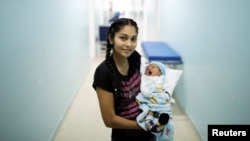Global life expectancy grew by 5.5 years between 2000 and 2016, the World Health Organization said Thursday, warning though that unequal income and access to healthcare translates into far shorter lives for many.
The U.N. health agency also stressed significant gender differences in life expectancy worldwide.
On average, a child born in 2016 can expect to live 72 years, up from 66.5 in 2000, according to the annual World Health Statistics report.
The first 16 years of the century saw dramatic drops in deaths among children under five, especially in sub-Saharan Africa, where progress has been made against malaria, measles and other communicable diseases, WHO said.
Life expectancy has also increased thanks to advances against HIV/AIDS, which ravaged much of Africa in the 1990s.
But despite progress in poorer countries, WHO said there remained significant life expectancy gaps between developed and developing nations.
People in low-income countries live 18 fewer years on average than those in high-income nations, statistics showed.
In Lesotho, for instance, people on average live to be just 52, or 53 in the Central African Republic 53 years of age, compared to over 83 for Switzerland and over 84 in Japan.
While most people who die in rich countries are old, nearly one in three deaths in poorer countries are children under five, WHO said.
'Shocking differences'
For the first time, WHO broke down its global health statistics by sex, clearly showing that females have better longevity prospects than males.
At birth, babies are more likely to be male than female, with some 73 million boys expected to be born this year, compared to 68 million girls, WHO said.
But due to greater biological frailty and riskier behaviours, mortality rates tend to be higher among boys and men, and the ratio shifts as the population ages.
At a global scale, girls born in 2016 are expected to live to the age of 74.2, while and boys on average will make it to 69.8 years, the report showed.
One reason why women appear to live longer is that they tend to be better about using available healthcare.
In countries facing HIV epidemics, for instance, women are far more likely to take HIV tests and access antiretroviral therapies than their male counterparts. Female TB patients are also more likely to seek treatment, WHO said.
It is therefore perhaps not surprising that the gap between men's and women's life expectancy is narrowest in places where women lack access to health services.
In low-income countries with scarcer services, one in 41 women die from maternal causes, compared to one in 3,300 women in high-income countries.
These are "shocking differences", WHO's head of data and analytics, Samira Asma, told reporters.
Overall, the statistics showed that life expectancy has risen in most countries, including significant jumps in places like Eritrea, where people on average are now expected to live 22 years longer than the 43 years predicted in 2000.
In Syria, meanwhile, which has been ravaged by eight years of conflict, life expectancy dropped by a decade, from 73 years in 2000 to 63.8 years in 2016.
People in the United States have meanwhile seen their life expectancy slip from 79 years in 2014 to 78.5 years two years later, the WHO numbers showed.
Asma said the drop was in part driven by the obesity epidemic.








